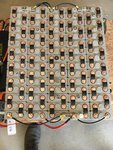I received the inverter last week and set up my LiFePO4, off grid charging system over the weekend. I used it once to charge the bike and everything worked just like I was plugged into the wall. The system consists of
75, CALB CA 40AH cells in a 15 series, 5 parallel configuration. System voltage is 48 VDC and has 10Kw of power. Size of the pack is about 23 inches by 28 inches. The batteries weigh about 240 lbs so the total system weight will be about 270 lbs, minus the Alta charger. I plan to box or bolt the batteries/inverter together so I can use an engine hoist to lift it into the back of my truck when I need it. I would have rather gone to a higher voltage to reduce the current and wire size, but I have a riding lawn mower I converted with 15 CALB CA100 AH cells, so by sticking with 48 Vdc, I can use the same charger for both systems.
I used a
3000W pure sine wave inverter I purchased off eBay for $266 USD. Inverter seems to work with no problems noted, but I have only used it once, so not sure how long it will last. The vendor I purchased the inverter from recommended the 3000W inverter for a 1500W continuous load so that is what I went with. You may be able to go smaller, but I would rather have the increased inverter capacity for longer life and future options. The vendor also recommended that I purchase an EMI filter for the inverter output. I did purchase that, but haven’t wired it up yet, so system test was without the filter. It seemed to work fine without the filter, but since I purchased the filter, I will probably use it.
At full charger operations the inverter draws about 30A with each of the 5 parallel battery legs providing about 6A. In the late phase of charging the system current draw decreased to less than 5A as the charger decreases the current to the bike battery. The battery is wired with 10ga wire or bradded straps connecting each parallel battery section together and then 6ga to the inverter. Total overkill, but I kind of believe in overkill with stuff like this. I have a 120A slow blow fuse in the hot lead to the inverter for safety and may install a contactor to switch on the power to the inverter.
I could have purchased a 240 Vac inverter to charge faster, but chose to go with 120 Vac. Most of the time when I use the inverter I will be camping, so going with 120 Vac gives me the options to use the inverter to power other items that I couldn’t power with 240. I also don’t see me riding more than once a day when camping so slower charging is not a big issue. Riding more than once a day for a couple of hours, probably would not be conducive for a good home. Happy wife, happy life.
There is no question that if you just want to charge you bike off grid, a generator is the cheapest option. The batteries alone for this project were about $4,500, but I purchased them for another project that didn’t work out, so I was using what I had. As has been mentioned before you could use the batteries out of a wrecked Leaf or Volt and that may be a cheaper option, but you would need to figure out the charger and BMS. I have the same type of CALB cells in my lawn mower and an earlier version of the cells in my converted 300zx. Both operate without a BMS and I have had no problems. I have been driving the car as my daily driver since 2011 and have about 40,000 miles on it so I am comfortable operating the CALB cells without a BMS. Below is a picture of the pack. On the left side of the photo you can see part of the inverter. This is just a test setup and when I finalize/finish the design, I will post pictures of the final system.
If you have any questions please do not hesitate to ask.
View attachment 614

